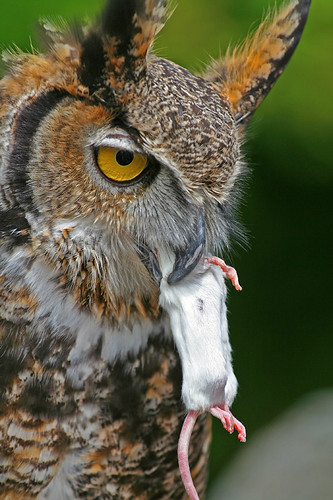The Great Horned Owl, a denizen of the North American avifauna, reigns supreme in its nocturnal domain. These puissant predators, recognizable by their prominent plumicorns (ear tufts) and penetrating gaze, are often perceived as apex predators, facing no threat from other faunal elements. However, the natural world operates on a complex hierarchy of interspecies interactions, and even the most formidable hunter is not immune to predation. This article delves into the unexpected reality of the Great Horned Owl’s vulnerability, exploring the predators that occasionally turn the tables on this avian juggernaut.
I. Intraspecific Aggression: The Owl vs. Owl Conflict
It is a surprising, yet significant, element in the owl’s predator-prey dynamic: other owls. Great Horned Owls, while solitary hunters, are fiercely territorial, especially during the breeding season. Competition for prime nesting sites and resource-rich hunting grounds can lead to aggressive encounters, sometimes resulting in mortality, particularly amongst younger or weaker individuals. Larger owl species, such as the Great Grey Owl in overlapping territories, may occasionally prey upon juvenile Great Horned Owls. These instances, though infrequent, serve as a harsh reminder of the internecine conflicts that shape owl populations.
Nest raiding is a common form of intraspecific predation. A rival owl might target the eggs or owlets of another pair, eliminating competition and securing resources for its own progeny. This behavior, while brutal, underscores the evolutionary pressures that drive survival and reproductive success within the owl community.
II. Avian Predators: A Flighted Foe
While Great Horned Owls are formidable avian predators themselves, they are not invulnerable to attacks from other birds. The Northern Goshawk, a swift and powerful accipiter, presents a significant threat, particularly to fledgling owls or incubating adults. Goshawks are renowned for their aggressive hunting style, often ambushing their prey with incredible speed and precision. Golden Eagles, apex predators of open landscapes, have been documented preying on Great Horned Owls on occasion. These raptors, with their immense size and strength, are capable of overpowering even adult owls.
Furthermore, diurnal raptors pose a significant threat to owlets left unattended. Hawks, vultures, and eagles will readily seize an opportunity to prey upon vulnerable young owls, especially if the nest is poorly concealed or the parent owls are absent. The risk from diurnal predators is a major factor influencing the nesting behavior and parental care strategies of Great Horned Owls.
III. Mammalian Menaces: Earthbound Threats
The terrestrial environment presents a range of predators that can pose a threat to Great Horned Owls, especially those nesting close to the ground or with limited escape routes. Fishers, members of the weasel family known for their arboreal agility and predatory prowess, are capable of climbing trees to raid owl nests. They are opportunistic predators and will readily consume eggs, owlets, or even injured adult owls.
Larger carnivores, such as coyotes and bobcats, may occasionally prey upon Great Horned Owls, particularly those hunting near ground level. These predators are typically opportunistic, seizing any available prey item. While not a primary food source, owls represent a supplemental source of nutrition, especially during periods of scarcity. The predation pressure from terrestrial mammals can influence the habitat selection and hunting strategies of Great Horned Owls, favoring areas with less ground cover and fewer potential ambush sites.
IV. The Predatory Pressure of the Human Element
Humans, though not traditionally considered a predator in the strict biological sense, exert a significant influence on Great Horned Owl populations through habitat alteration, persecution, and indirect effects. Deforestation, urbanization, and agricultural expansion reduce the availability of suitable nesting sites and hunting grounds, forcing owls to compete for dwindling resources and increasing their vulnerability to predation. Collisions with vehicles and power lines are a significant source of mortality, particularly amongst young owls dispersing from their natal territories.
Historically, owls were often targeted by hunters and farmers due to misconceptions about their impact on game populations and livestock. While direct persecution has declined in many areas, illegal shooting and trapping still pose a threat. Furthermore, the use of rodenticides can indirectly impact owl populations by poisoning their prey base, leading to bioaccumulation and potential mortality.
V. Implication of Predation on Owl Behavior and Ecology
The threat of predation has shaped the behavior and ecology of Great Horned Owls in profound ways. Their nocturnal habits, cryptic plumage, and powerful talons are all adaptations that enhance their hunting success and reduce their vulnerability to predators. Great Horned Owls exhibit strong parental care, fiercely defending their nests and young from potential threats. The selection of nest sites is also influenced by predation risk, with owls often choosing locations that provide concealment and limited access to terrestrial predators. The presence of predators can also influence the hunting strategies of Great Horned Owls, favoring areas with lower predator densities and increased prey availability. The ongoing interplay between predator and prey continues to mold the evolutionary trajectory of this magnificent avian predator.
